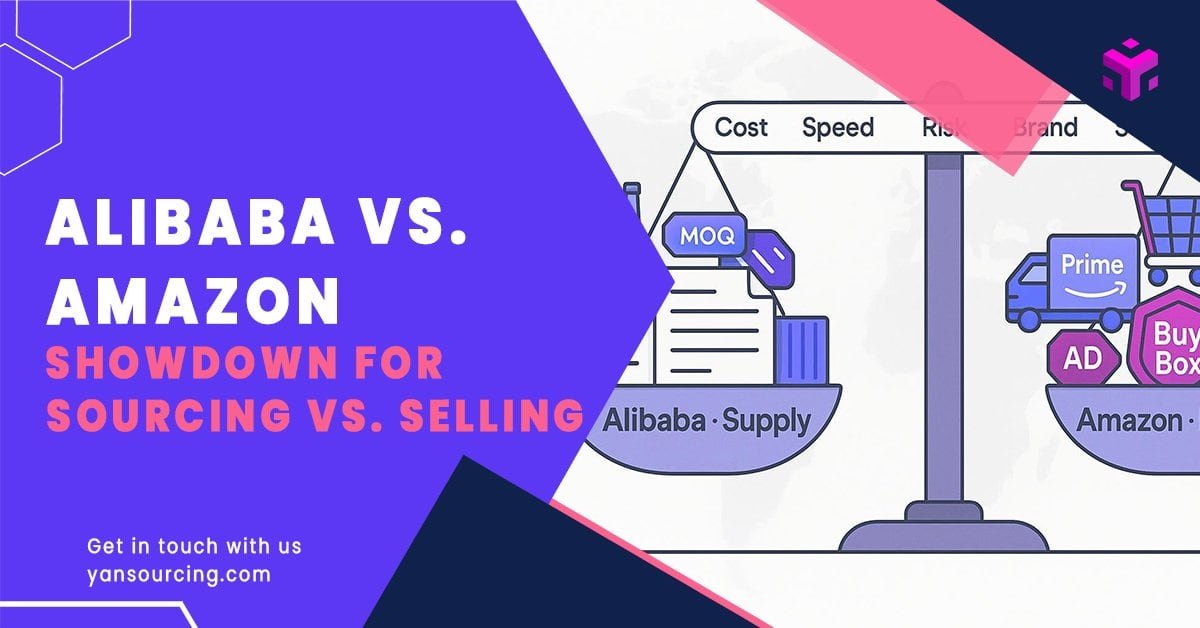
If you’re an e‑commerce founder deciding between Alibaba and Amazon, here’s the cleanest way to think about it: Alibaba determines whether you can control cost; Amazon determines whether you can capture customers. They do different jobs in your go‑to‑market—and the strongest brands often use both.
A “most telling” pair of moments from real operator life:
- On Alibaba, you negotiate supply: a furniture buyer pushes MOQ from 500 to 200 units, drops unit price from $60 to $48, and compresses lead time from 60 to 40 days.
- On Amazon, you fight for demand capture: after launch, FBA storage plus advertising can eat roughly a third of gross margin, and the Buy Box can still be elusive even if your price is sharp.
Below, we compare Alibaba (B2B sourcing/manufacturing) vs. Amazon (B2C marketplace for selling) using the C‑S‑R‑B‑S framework: Cost, Speed, Risk, Brand Control, and Scale—pragmatic, numbers‑first, and 2025‑specific.
Note: Fee policies and logistics evolve. All fee and policy references are “as of 2025,” with links to primary sources where possible.
Cost: Who controls the unit economics?
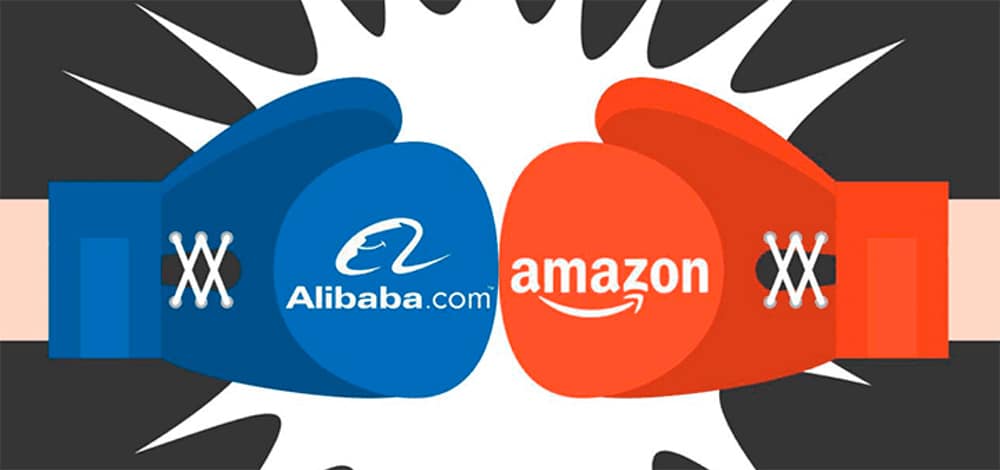
On Amazon, your cost stack includes referral fees, FBA fulfillment, storage surcharges, inbound placement, coupons, and advertising.
Official guidance shows category referral fees typically in the 8%–15% range (exceptions exist, calculated on the total sales price) according to Amazon’s Selling on Amazon fee schedule (2025). See Amazon’s help hub: Selling on Amazon fee schedule (2025, Seller Central Help).
For FBA fulfillment in 2025, rates vary by size tier/weight; for example, standard‑size brackets show representative per‑unit fees in the $3.6–$4+ range for light items. Reference Amazon’s 2025 table: FBA fulfillment fee (2025, Seller Central Help).
Storage is monthly, charged per cubic foot (higher in Q4) and includes aged inventory surcharges beyond 365 days—see Monthly inventory storage fees (2025, Seller Central Help).
Inbound placement service fees apply depending on shipment split options—see the 2024–2025 program notes in the Seller Forums overview: Inbound placement fee options (2024–2025, Amazon Seller Forums).
Coupons also carry a per‑redemption fee (e.g., $0.60 as listed in early 2025) per Coupon fees (2025, Seller Central Help). For scenario modeling, use Amazon’s official tools: Estimate selling fees and costs (2025, Amazon).
On Alibaba, you shape cost at the source through RFQ specificity, supplier selection, MOQ negotiation, lead‑time trade‑offs, and Incoterms.
Alibaba’s Trade Assurance acts like escrow with on‑time delivery and quality protection for covered orders; learn the mechanics here: How Trade Assurance protects your purchases (2025, Alibaba Reads).
The newer Alibaba Guaranteed program offers fixed prices including shipping, guaranteed dispatch/delivery windows, and money‑back guarantees for delays, loss, or defects on eligible listings; see Introducing Alibaba Guaranteed (2025, Alibaba Reads). For sourcing workflows and RFQ details, see RFQ on Alibaba.com (2025, Alibaba Reads).
Mini‑case (Beauty accessories; anonymized):
- Before (Amazon wholesale/retail arbitrage): unit cost $6.00; landed cost $7.20; price $12.90; gross margin ~20%; return rate 8%.
- After (Alibaba private label, factory custom): factory price $2.80; landed cost $3.60; price $12.90; gross margin ~55%; return rate 3% (thanks to third‑party QC and custom packaging).
What changed? On Alibaba, the operator gained direct control over BOM, materials, packaging, and order size. The landed cost halved, margin more than doubled, and returns fell.
Pragmatic cost checklist
- Alibaba levers: precise RFQ (materials/specs/packaging), verify “factory vs. trader,” negotiate MOQ/price/payment terms (e.g., 30/70), align on lead time and inspection, choose Incoterm wisely (EXW/FOB/CIF/DDP).
- Amazon levers: match category referral fee, choose FBA vs. FBM mix, monitor storage/aged inventory surcharges, optimize inbound placement option, test coupons sparingly, and manage ads ACoS/ROAS with conversion‑first tactics.
- Validate with tools: Amazon Revenue Calculator and Fee Preview; supplier quotes under Trade Assurance or Alibaba Guaranteed with fully loaded freight and duty.
Caution: Category variance is huge (e.g., furniture vs. beauty vs. electronics can differ by >30% in margin structure). Always validate with current quotes and help pages.
Speed: How fast can you ship, list, and sell?
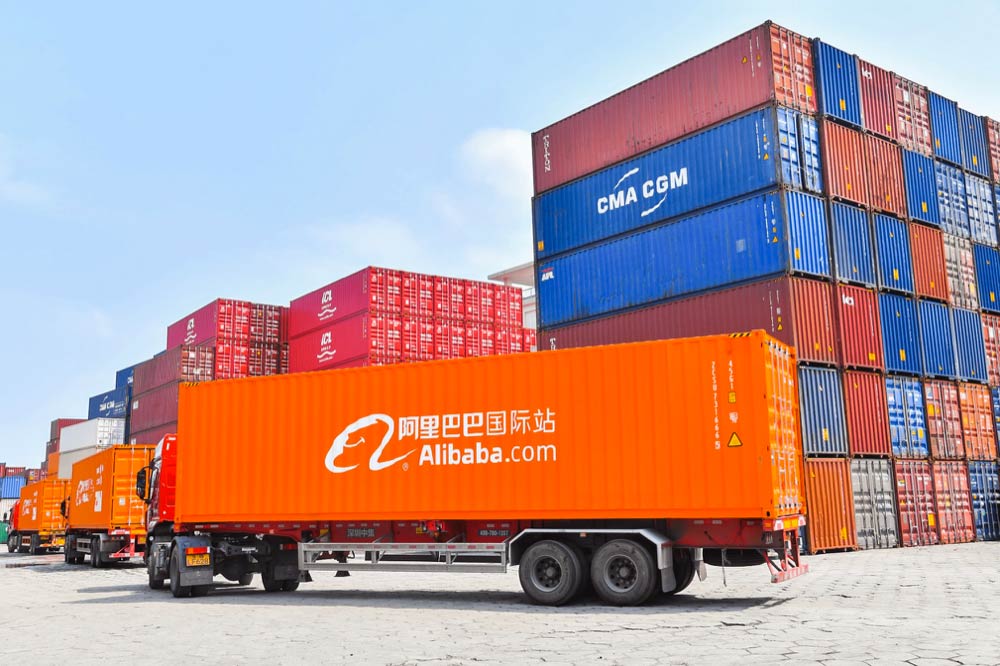
Alibaba speed is about compressing production and shipping timelines. In the furniture scenario, negotiation pushed lead time from 60 to 40 days by adjusting materials, production slotting, and QC checkpoints.
Alibaba’s own workflow guidance emphasizes detailed specs and supplier shortlisting to reduce back‑and‑forth—see How Alibaba works: step‑by‑step sourcing (2025, Alibaba Reads).
Logistics set the floor for speed‑to‑stock. Directionally, ocean freight from China to the US can run about 38 days to the West Coast and 51–60 days to the East Coast, while North Europe lanes can take roughly 57–64 days, per mid‑2025 trend briefings in Flexport’s Global Logistics Updates (2025).
Air freight is far faster (often 3–7 days airport‑to‑airport; courier‑to‑door can be 7–15 days depending on service level), but costs spike accordingly.
Amazon speed is about time‑to‑first‑sale. Once inventory clears inbound and your listing is live, you can reach customers quickly with Sponsored Products (CPC) campaigns and fast delivery via FBA. For ad basics and metrics definitions, see New advertiser success guide (2025, Amazon Advertising).
FBA fulfillment fees already bundle Prime‑eligible shipping to customers, with 2025 rates documented here: FBA fulfillment fee (2025, Seller Central Help).
When speed matters most
- Seasonal windows: prioritize air freight/pilot batches to hit demand spikes.
- New product validation: use small MOQs, rapid sampling, and early PPC to see signal before scaling.
- Cash cycles: shorten supplier deposits through smaller pilots; avoid over‑stocking to reduce Q4 storage surcharges.
Risk: What can actually go wrong—and how do you control it?
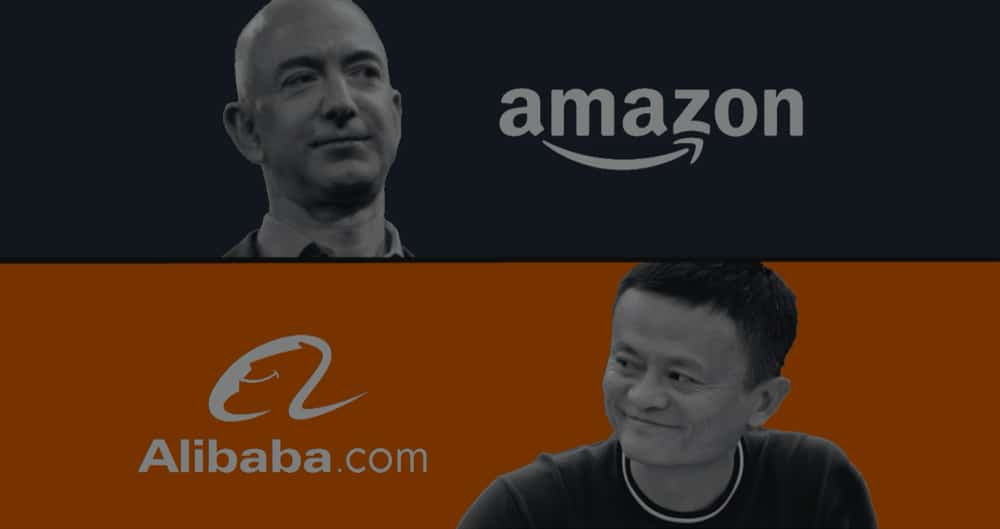
Alibaba‑side risks and mitigations
- Impostor “factories” (actually small trading firms). Mitigate by using Alibaba’s Verified Supplier badges and conducting checks like business licenses, on‑site/virtual factory tours, and sample comparisons; see How to find great suppliers (2025, Alibaba Reads).
- Quality variability. Use staged inspections (pre‑production, during production, pre‑shipment) via reputable providers and start with pilot batches; context: QIMA inspection services overview. Pair with Trade Assurance to escrow payments and set clear specs: Trade Assurance protections (2025, Alibaba Reads).
- IP leakage (designs used or resold). Before sharing sensitive details, deploy China‑specific NNN agreements and clear product development contracts; see the legal guidance in Harris Bricken on China product development agreements (2024).
Amazon‑side risks and mitigations
- Account suspension and policy violations. Maintain strict compliance and monitor performance metrics tied to Featured Offer eligibility (ODR, cancellation, late shipment). For official context, see Seller guidance around the Featured Offer (“Buy Box”) and eligibility columns: Featured Offer eligibility notes (2024–2025, Amazon Seller Forums).
- Fee creep (storage, inbound placement, coupons), plus advertising spend. Institute a cost review cadence and consider 3PL/off‑Amazon warehousing to avoid aged inventory surcharges; see Monthly inventory storage fees (2025, Seller Central Help).
- Cut‑throat competition (price battles, reviews). Differentiate via design and packaging (leveraged upstream on Alibaba). Enroll in Brand Registry to unlock A+ Content and protection tools; see Brand Registry requirements (2025, Amazon).
Practical risk checklist
- Supplier vetting: Verified badges, license checks, sample comparisons, factory videos.
- Legal/IP: NNN agreement before sharing CAD/tooling; clarify ownership of molds and artwork.
- Quality control: Pilot lots + third‑party inspections at each phase; tie specs to payment milestones.
- Amazon compliance: Audit listings against policies; monitor ODR/cancellations; keep safety/compliance docs handy.
- Cost discipline: Track storage age, inbound placement choices, coupons, and ACoS/ROAS.
Brand Control: Private label leverage vs. platform dependence
Alibaba is where you design and control the product: OEM/ODM options, materials, molds, packaging, and even compliance labeling. That’s how you build enduring brand equity and reduce me‑too competition.
Amazon is where you win the right to be seen and trusted: Brand Registry requires a registered or pending trademark and enables A+ Content, Vine, and protection tools that strengthen conversion and safeguard reputation—see Brand Registry requirements (2025, Amazon). But Amazon’s platform rules still set the frame: fee structure, review policies, and Featured Offer criteria.
Operator takeaway: Use Alibaba to create differentiation (and cost control) and Amazon to turn that differentiation into traffic and conversion.
Scale: Capacity on the supply side, traffic on the demand side
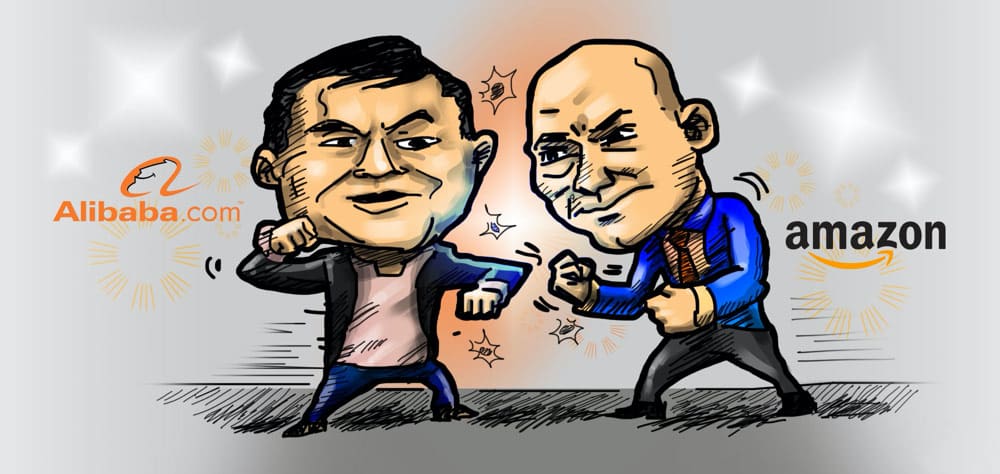
Supply‑side scale (Alibaba)
- Capacity planning: qualify at least two capable factories; define backup tooling and tolerances.
- Lead‑time resilience: agree on surge capacity windows and raw material buffers for peak seasons.
- Quality systems: standardize QC checklists and sampling plans; lock down packaging specs to reduce damage/returns.
Demand‑side scale (Amazon)
- Advertising maturity: progress from exploratory Sponsored Products to structured campaigns; know how to interpret ACoS/ROAS and incrementality; see Reports and metrics (2025, Amazon Advertising).
- Featured Offer share: inventory availability, competitive landed price, and delivery speed all matter; manage fees to protect price competitiveness while staying eligible.
- Channel balance: diversify gradually (e.g., Amazon + Shopify) once supply is stable; avoid over‑exposure to any single policy change.
Decision branches by capital and risk appetite
- <$20K to start: pick SKUs with micro‑MOQs, simple BOMs, low defect risk; ship initial lots by air; test ads lightly.
- Scaling on tight cash: negotiate 30/70 payment terms and phased inspections; slow inventory age with conservative purchase orders; optimize listings for conversion to lower ACoS.
- Brand‑first strategy: invest in ODM features, packaging, and certifications; build review velocity ethically via Vine once enrolled in Brand Registry.
Sidebar: AliExpress vs. Amazon vs. Alibaba (one‑line litmus test)
- AliExpress: small‑quantity consumer purchases with retail‑style checkout; standard delivery often 15–45 days to the US and 7–15 days on premium services per AliExpress shipping timelines (2025, AliExpress blog).
- Amazon: marketplace for selling to consumers at scale; strict rules and a layered fee stack (referral, FBA, storage, ads) per Selling on Amazon fee schedule (2025, Seller Central Help) and FBA fulfillment fee (2025, Seller Central Help).
- Alibaba: B2B sourcing/manufacturing hub to negotiate MOQ, price, and lead time with buyer protections like Trade Assurance (2025, Alibaba Reads).
Action plan: MVP to first sales, step by step
- Define the spec: write a crisp RFQ (materials, dimensions, packaging, testing standards) and post to vetted suppliers on Alibaba; see RFQ on Alibaba.com (2025, Alibaba Reads).
- Protect IP: before sharing drawings/tooling, execute a China‑specific NNN agreement and clarify mold ownership per Harris Bricken’s guidance (2024).
- Sample and iterate: compare samples from 2–3 short‑listed factories; pressure‑test build quality and packaging.
- Pilot order: negotiate MOQ, lead time, and 30/70 terms under Trade Assurance or Alibaba Guaranteed; set inspection milestones.
- Inspect: pre‑production, in‑process, and pre‑shipment inspections with a reputable third party like QIMA; tie payments to passed inspections.
- Ship and clear: choose air for speed or ocean for cost; plan for inbound placement choices on Amazon to balance fees/time.
- List and launch: enroll in Brand Registry when eligible, build A+ Content, and start Sponsored Products; see New advertiser success guide (2025, Amazon Advertising).
- Review unit economics: run the Amazon Revenue Calculator, monitor storage age and ACoS, and iterate pricing/ads to hit target contribution margin.
Risk disclaimer: No guide can guarantee profit. Category economics vary widely, and results depend on execution quality, compliance, and market dynamics.
Also consider: execution partners for sourcing
If you lack the time or expertise to run supplier discovery, QC, and logistics end‑to‑end, a reputable sourcing agent can help you navigate RFQs, inspections, and shipments while you focus on listings and conversion.
One such provider is Yansourcing, a China‑based sourcing agent offering supplier vetting, production management, inspections, and logistics for e‑commerce sellers.
The bottom line
- On Alibaba, MOQ and lead time decide whether you survive; on Amazon, ad and storage fees decide whether you survive long. In practice, the winning playbooks combine them: squeeze cost and quality upstream on Alibaba, then convert demand on Amazon with tight compliance and disciplined cost control.
- Start small, validate with a pilot, measure everything, and scale only what works. Use official calculators and help pages to keep your 2025 assumptions current.
